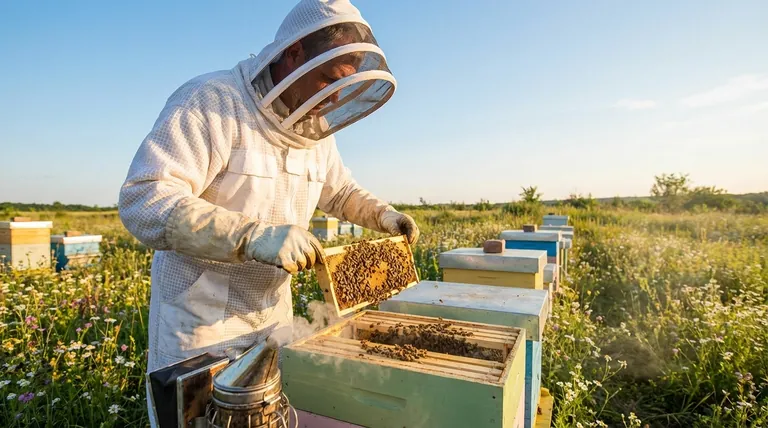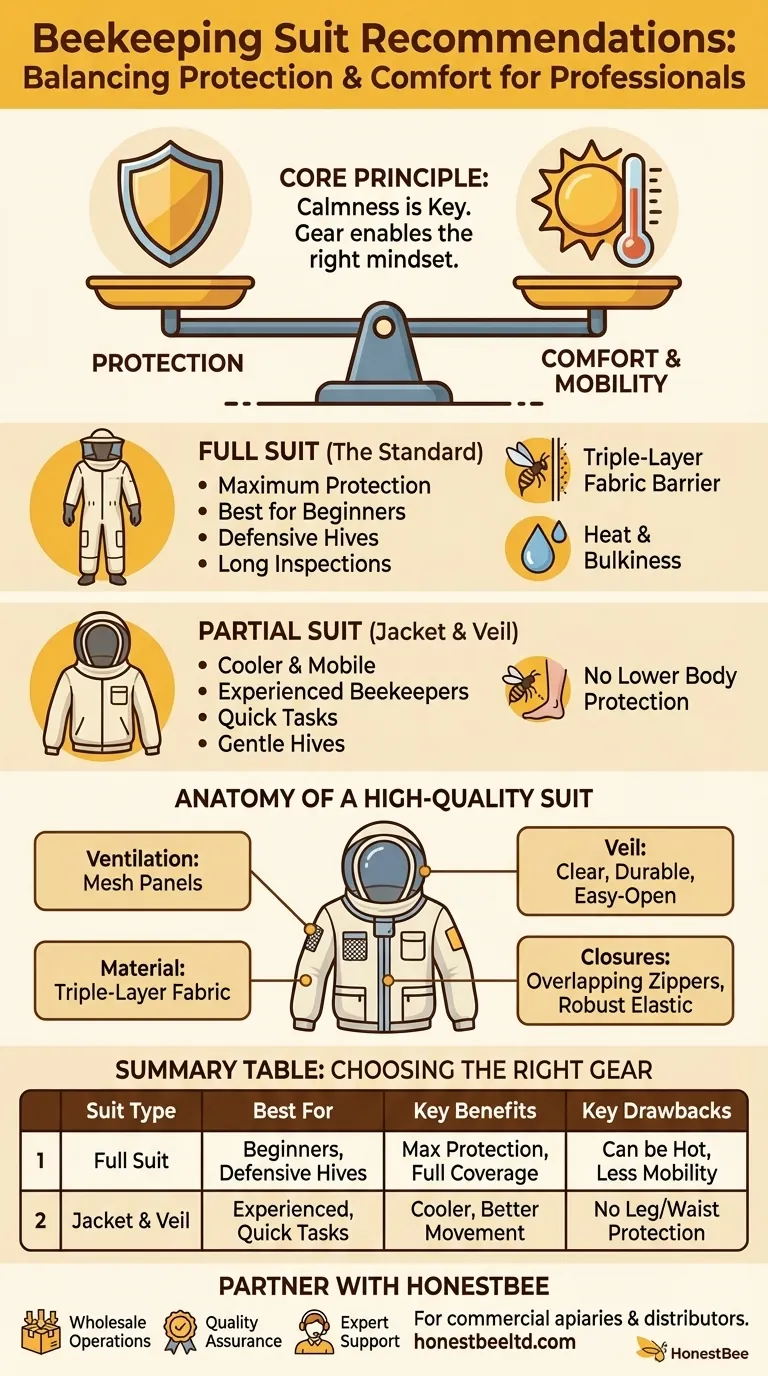The definitive recommendation is to always wear a beekeeping suit for protection. While experienced beekeepers sometimes opt for less, a quality suit is essential for building confidence and ensuring safety. The best choice depends on balancing the absolute need for sting protection against factors like climate, hive temperament, and your personal comfort.
The core decision is not if you should wear protective gear, but what level of protection is appropriate. The right beekeeping suit allows you to remain calm and focused on your bees, which is the foundation of safe and effective beekeeping.

The Core Principle: Balancing Protection and Comfort
Effective beekeeping requires you to be calm and deliberate. A constant fear of being stung makes this impossible. Your protective gear is the tool that enables the right mindset.
Why Full Protection is the Standard
For new beekeepers, a full suit is non-negotiable. It provides head-to-toe protection, which removes the distraction of potential stings.
This allows you to focus on learning bee behavior and performing hive inspections correctly, building the calm confidence necessary for the craft.
The Reality of Heat and Mobility
The primary drawback of a full suit is heat retention and bulkiness. Working in a heavy suit on a hot day can be exhausting and increase the risk of overheating.
This is the main reason beekeepers seek alternatives or invest in suits with advanced ventilation.
Partial Suits as an Alternative
Partial suits, such as a jacket and veil combination, offer a compromise. They are cooler, easier to put on, and allow for better movement.
However, they offer significantly less protection for the lower body, representing a trade-off that is generally only suitable for quick tasks or highly experienced individuals with calm hives.
Anatomy of a High-Quality Beekeeping Suit
Not all suits are created equal. Specific features dramatically impact a suit's safety, durability, and comfort.
Material and Ventilation
The best modern suits use a triple-layer fabric. This design creates a physical gap that is too deep for a bee's stinger to penetrate.
Look for suits that incorporate mesh panels or use highly breathable fabrics, as these features are critical for air circulation and preventing overheating during long inspections.
The Critical Importance of the Veil
Your veil is your window into the hive. It must be made of high-quality, durable, and clear material that offers excellent visibility without distortion.
An easy-open front veil is a valuable feature, allowing you to get a drink or clear your glasses at a safe distance from the hive without removing the entire hood.
Secure Closures and Openings
Bees are experts at finding small gaps. High-quality suits feature overlapping zippers to create a sting-proof seal.
Pay close attention to the velcro and elastic at the wrists and ankles. These must be robust to prevent bees from crawling inside the suit. An extra-long leg zipper also makes it much easier to put the suit on over boots.
Understanding the Trade-offs
Choosing your gear involves a clear understanding of what you gain and what you give up with each option.
The Case for a Full Suit
A full bee suit offers maximum protection and peace of mind. It is the ideal choice for beginners, for working with defensive or unknown colonies, and for performing complex, time-consuming hive manipulations.
Its main downsides are its weight, potential for overheating, and being more cumbersome to wear.
The Case for a Partial Suit (Jacket & Veil)
A partial suit is significantly cooler and allows for greater freedom of movement. It's faster to put on for quick tasks like refilling a feeder.
The obvious and critical downside is the lack of protection for your legs and waist. This is a risk that should only be accepted by experienced beekeepers who fully understand their bees' temperament.
Making the Right Choice for Your Goal
Select your gear based on your experience level and primary objective.
- If your primary focus is maximum safety and learning (Beginner): Choose a full, triple-layer ventilated suit to eliminate sting anxiety and focus on your bees.
- If your primary focus is comfort in a hot climate: Invest in a high-quality ventilated suit, as preventing overheating is critical for safety and endurance.
- If your primary focus is speed for simple tasks (Experienced): A partial jacket and veil may be sufficient for quick inspections of a known, gentle hive.
Ultimately, your protective gear should feel like a tool that empowers you to be a better, more attentive beekeeper.
Summary Table:
| Suit Type | Best For | Key Benefits | Key Drawbacks |
|---|---|---|---|
| Full Suit | Beginners, defensive hives, long inspections | Maximum sting protection, full-body coverage, ideal for learning | Can be hot, less mobility, more cumbersome |
| Jacket & Veil | Experienced beekeepers, quick tasks, gentle hives | Cooler, easier to put on, greater freedom of movement | No protection for legs/waist, higher risk of stings |
Equip yourself with confidence and safety. Partner with HONESTBEE for your beekeeping supply needs.
Whether you manage a commercial apiary or distribute equipment, the right protective gear is non-negotiable for safety and productivity. HONESTBEE supplies durable, high-performance beekeeping suits and equipment designed for the demands of professional beekeeping.
We provide:
- Wholesale-Focused Operations: Competitive pricing and bulk ordering for commercial clients and distributors.
- Quality Assurance: Reliable suits with features like triple-layer fabric and secure closures for maximum protection.
- Expert Support: Guidance to select the right gear for your specific climate and hive conditions.
Ready to outfit your team with the best? Contact HONESTBEE today to discuss your wholesale requirements and ensure every beekeeper is properly protected.
Visual Guide

Related Products
- Cotton Beekeeping Suit and Round Hat with Veil Bee Keeper Protective Gear
- White Beekeeping Protective Suit and Hat with Fencing Veil for Beekeepers
- Heavy Duty Cowboy Beekeeper Hat with Visibility Veil Outdoor Professional Beekeeping Protective Gear
- Beekeeper Cowboy Hat and Veil for Beekeeping
- Professional Beekeeping Suit for Kids and Girls Childrens Bee Keeper Suit
People Also Ask
- What should be considered regarding the color of beekeeping clothing? Ensure Your Safety and Keep Bees Calm
- What are bee suits made of? Choosing the Right Material for Maximum Protection & Comfort
- What are the benefits of a fully ventilated beekeeping suit? Stay Cool and Protected in Hot Climates
- Why is white the predominant color in bee suit designs? | Key to Hive Calm & Beekeeper Safety
- How should a bee suit be cleaned? Protect Your Investment and Ensure Apiary Safety



















